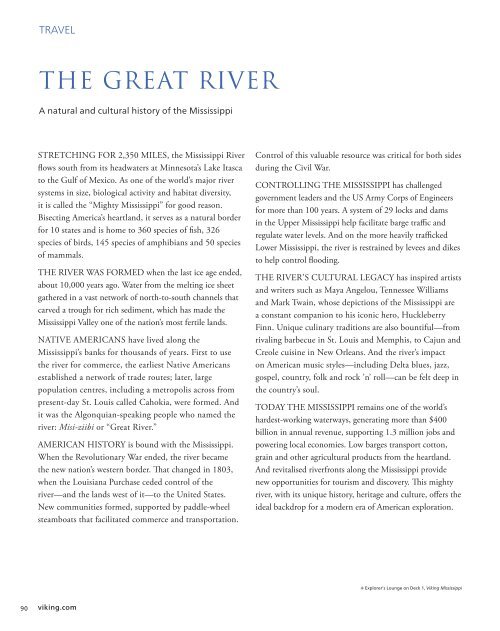Viking Traveller 2nd Issue
Create successful ePaper yourself
Turn your PDF publications into a flip-book with our unique Google optimized e-Paper software.
TRAVEL<br />
THE GREAT RIVER<br />
A natural and cultural history of the Mississippi<br />
STRETCHING FOR 2,350 MILES, the Mississippi River<br />
flows south from its headwaters at Minnesota’s Lake Itasca<br />
to the Gulf of Mexico. As one of the world’s major river<br />
systems in size, biological activity and habitat diversity,<br />
it is called the “Mighty Mississippi” for good reason.<br />
Bisecting America’s heartland, it serves as a natural border<br />
for 10 states and is home to 360 species of fish, 326<br />
species of birds, 145 species of amphibians and 50 species<br />
of mammals.<br />
THE RIVER WAS FORMED when the last ice age ended,<br />
about 10,000 years ago. Water from the melting ice sheet<br />
gathered in a vast network of north-to-south channels that<br />
carved a trough for rich sediment, which has made the<br />
Mississippi Valley one of the nation’s most fertile lands.<br />
NATIVE AMERICANS have lived along the<br />
Mississippi’s banks for thousands of years. First to use<br />
the river for commerce, the earliest Native Americans<br />
established a network of trade routes; later, large<br />
population centres, including a metropolis across from<br />
present-day St. Louis called Cahokia, were formed. And<br />
it was the Algonquian-speaking people who named the<br />
river: Misi-ziibi or “Great River.”<br />
AMERICAN HISTORY is bound with the Mississippi.<br />
When the Revolutionary War ended, the river became<br />
the new nation’s western border. That changed in 1803,<br />
when the Louisiana Purchase ceded control of the<br />
river—and the lands west of it—to the United States.<br />
New communities formed, supported by paddle-wheel<br />
steamboats that facilitated commerce and transportation.<br />
Control of this valuable resource was critical for both sides<br />
during the Civil War.<br />
CONTROLLING THE MISSISSIPPI has challenged<br />
government leaders and the US Army Corps of Engineers<br />
for more than 100 years. A system of 29 locks and dams<br />
in the Upper Mississippi help facilitate barge traffic and<br />
regulate water levels. And on the more heavily trafficked<br />
Lower Mississippi, the river is restrained by levees and dikes<br />
to help control flooding.<br />
THE RIVER’S CULTURAL LEGACY has inspired artists<br />
and writers such as Maya Angelou, Tennessee Williams<br />
and Mark Twain, whose depictions of the Mississippi are<br />
a constant companion to his iconic hero, Huckleberry<br />
Finn. Unique culinary traditions are also bountiful—from<br />
rivaling barbecue in St. Louis and Memphis, to Cajun and<br />
Creole cuisine in New Orleans. And the river’s impact<br />
on American music styles—including Delta blues, jazz,<br />
gospel, country, folk and rock ’n’ roll— can be felt deep in<br />
the country’s soul.<br />
TODAY THE MISSISSIPPI remains one of the world’s<br />
hardest-working waterways, generating more than $400<br />
billion in annual revenue, supporting 1.3 million jobs and<br />
powering local economies. Low barges transport cotton,<br />
grain and other agricultural products from the heartland.<br />
And revitalised riverfronts along the Mississippi provide<br />
new opportunities for tourism and discovery. This mighty<br />
river, with its unique history, heritage and culture, offers the<br />
ideal backdrop for a modern era of American exploration.<br />
X Explorer’s Lounge on Deck 1, <strong>Viking</strong> Mississippi<br />
90 viking.com
















